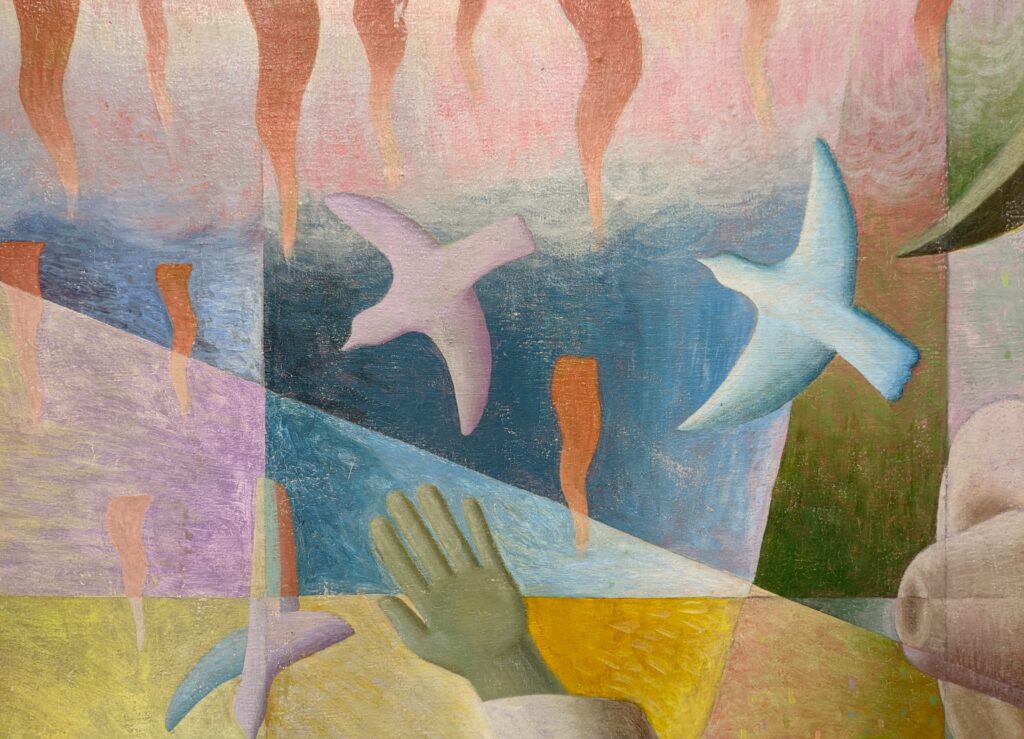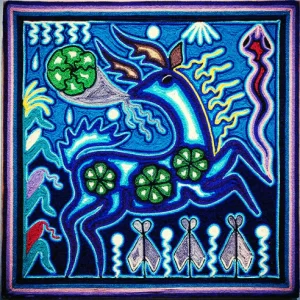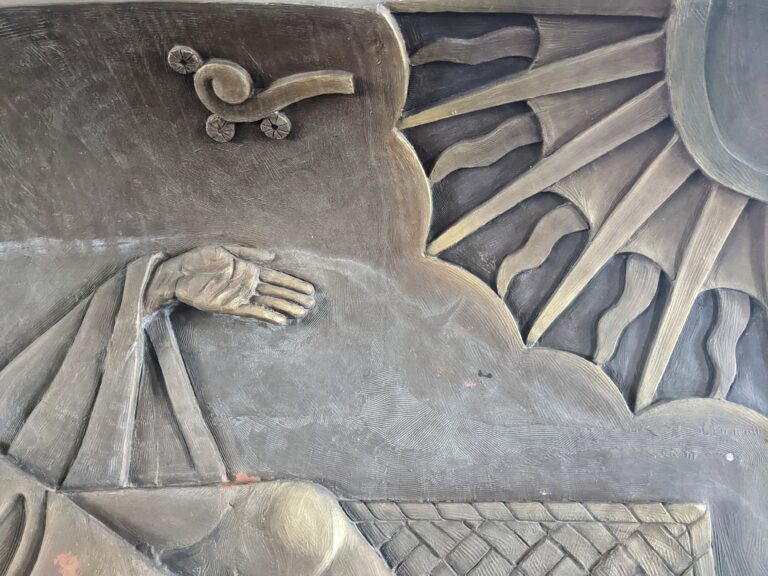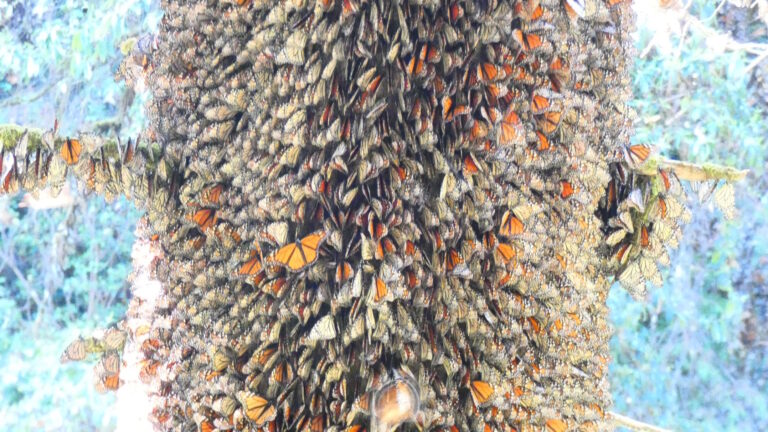
The following is an excerpt from “Fragile Messengers,” a book-length memoir. When its narrator, a middle-aged white American, experiences the wonder of the monarch migration for the first time, she falls in love with both the butterflies and her young Mexican guide. She moves to his village, a tiny town at the entry of a monarch butterfly sanctuary, where the couple creates a thriving ecotourism business and fights illegal logging of the forest.
Over time, what seemed like a fairy tale morphs into a gothic romance. Our heroine, who’d thought she’d escaped the loneliness of her family of origin by marrying into a large, tight-knit, working-class Mexican family, comes to see how similar the two are. She knows that she needs to leave her situation but feels stuck.
After the woman purchases a house in San Miguel de Allende, her parents come to visit. The mother, whose sharp edges have been softened by dementia, tells her daughter that she was, “always a wonderful child.” These words snap the woman out of her trance of unworthiness. Yet she doesn’t feel like she has the strength to leave her marriage until a series of psychedelic experiences provide her with the symbolic resources to reimagine her life.
My elation about my conversation with my mother continued for several days after my parents left San Miguel. In the mornings, I sat on the rooftop savoring my morning coffee and gathering my thoughts while the sky pinkened behind the branches of the mesquite tree that peeked over the rooftop. Hot air balloons passed over head, close enough to see the weave on the bottom of their baskets and hear the roar of the propane flame propelling them up, up and away.
Like any high, these good feelings didn’t last. A few mornings later, I found myself on the roof staring dully into space, feeling annoyed by the ever-present sounds of construction: insistent hammering, the whirr of power drills, tinny tunes on a transistor radio. Even the thrill seekers bobbing by in balloons started to seem intrusive. These contraptions skimmed precariously close to the rooftop water tanks, startling the pigeons skyward with a clattering of wing claps.
When I walked my dog Panda around the nearby soccer fields, I saw what happened to these balloons after the tourists disembarked. The empty basket lay toppled on its side while workers grimly tugged the balloon to the dusty ground, trying to press the air out with palpable impatience.
I too felt deflated. Perhaps I had been a wonderful child, but I had not lived my life in a way that honored that wonder. All the decisions I had made came from the conviction that I was somehow deficient. Even things that had seemed like a good idea at the time, like attaching myself to Esteban, had devolved: we had more bad days than good, more fights than not, and arguments always ended with him telling me that how I felt didn’t matter.
During this funk, I was supposed to meet a new friend for lunch. I messaged and canceled, explaining that I felt too depressed to see anyone. Suzanne called me right away and listened as I related what had happened with my mom.
“No need for you to feel depressed. We’ll fix that,” she said. Semi-retired, she had a side business doing psychedelic therapy. “We’ll do some ketamine sessions. It’s the businesswoman’s mushrooms—it just takes an hour, and then you can get back to work.”
A horse tranquilizer used legally in the U.S. to treat anxiety and depression in humans, ketamine is said to smooth out the ruts in the brain created by obsessive thoughts, creating the possibility of new neuro-connections.
A few days later, I got up well before Esteban and took a taxi across town to Suzanne’s rented mansion. I hadn’t told him about my plan to take ketamine because I knew he would disapprove of drug use.
Suzanne led me to the master bedroom and handed me a shot glass filled with chunky grey crystals. I tossed them under my tongue and then lay on her bed with eyeshades on, feeling an acrid chemical burn trickle down my throat, numbing my mouth. Salivating, I tried hard not to swallow before the drug took effect. Gradually, the trippy music playing in my borrowed headphones started to sound profound rather than cheesy.
As my body floated away, I became aware of fluttering activity in my heart. There was an angry little deer trapped within its chambers. The stag looked abstract and colorful, like something from the Huichol yarn paintings I loved. It alternated charging with its jagged antlers and mule kicking with its sharp back hooves, lacerating the walls of my heart until they bled. Pressing my sweating hands to my sternum, I felt a painful liquid weeping welling up inside.
I knew that the deer was Esteban. “I’ve got to get him out,” I thought.

After a few more days of decompression in San Miguel, the time came to return to Esteban’s village for a few weeks. The drive home took us through flashing rows of blue agave followed by the white plastic hoop houses of industrial-scale strawberry production. The state of Guanajuato bid us adieu and we entered a pot-holed no man’s land before Michoacan welcomed us with a major interchange of roads that led to the coast or the capital. We stayed straight and the highway abruptly dumped into the meandering main thoroughfare of medium-sized Maravatio.
As we exited that town’s perpetual traffic jam, we passed a round, pink chapel by the side of the road. A glassed-in shrine held a massive statue of the Virgin of Guadalupe with Juan Diego kneeling at her feet. Above this diorama, the words NO ESTOY YO AQUI QUE SOY TU MADRE were painted in an angular Grecian-style script. I turned the phrase over idly in my head.
The chapel marked the halfway point of the four-hour long journey, the moment where I started feeling anxious about what awaited us in Macheros. As soon as we arrived, Esteban always said, “Lets go down to my mom’s to say hi.” And while his mom smiled at the sight of us and offered us the chiles rellenos or pozole that las muchachas had made, las muchachas themselves ostentatiously ignored us. No matter how long we’d been away, the sisters’ greetings from where they sat in the corner of the kitchen, transfixed by the TV, were perfunctory to nonexistent. At most, one might laconically mutter, “Que milagro.” What a miracle.
When we pulled into the driveway, I said to Esteban, “You go ahead.” Being alone felt better than feeling lonely in the presence of so many other people.
I spent the rest of the time in Macheros by myself in the house, eagerly awaiting the day we would return to San Miguel. As soon as we got back, I organized another ketamine session. Installed again in Suzanne’s bedroom, masked and propped up by pillows, the crunchy powder under my tongue tasted even nastier than before. My stomach lurched with nausea until the drug took effect and my body disappeared. This time, the phrases from the chapel at the halfway point of our drive flashed before me:
NO ESTOY YO AQUI
QUE SOY TU MADRE
They ran through my head like a catchy commercial jingle on a loop, defying my efforts at tidy translation into English.
Aren’t I here,
she who is your mother?
According to lore, the Virgin Mary spoke these words to a humble peasant named Juan Diego in 1531 when she appeared to him on Tepeyac, a hill on the eastern side of Mexico City that was associated with the Aztec earth goddess Tonanzin. The Virgin asked him to tell the bishop to build her a temple, but church elders refused to believe an indigenous Mexican. In a subsequent encounter, the Virgin filled Juan Diego’s cloak with out-of-season roses, and when he emptied them out at the feet of the skeptical Europeans, the Virgin of Guadalupe’s distinctive image had been burned into the fabric of his cloak.
The Virgin of Guadalupe and I had met before. During one ecstatic weekend when Esteban and I were still dating, we’d met up in Mexico City and spent a sozzled weekend holed up in a rented studio next to the Alameda. We dressed and left our quarters only once, to take the subway out to the basilica on December 12, her patron saints’ day.
As the crowded train disgorged us into a mob that flowed out of the station, up the boulevard and into her complex, my feelings of private pleasure converged with collective effervescence. Pilgrims with small Virgin of Guadalupe statues strapped to their backs fell to their knees to crawl the last few steps. Aztec dancers with elaborate feather headdresses beat drums and stomped in well-rehearsed unison in the courtyard outside a sixties-style, flying saucer-shaped sanctuary. Inside the church, large crowds listened to droning priests delivering around the clock masses in front of a massive Virgin of Guadalupe statue looming over an equally grand red, white and green national flag. The experience reminded me of how I’d felt when I’d seen the monarch migration a year earlier: as if I were at long last a part of something larger than myself. My burgeoning feelings for the Mexican man by my side mingled with my love for the entire country.
Once I moved to Macheros, the flickering of belonging that I felt that day was slowly extinguished, despite the fact that our neighbors staged an equally fervent celebration of Mexico’s patron saint that went on for weeks. A procession of the devout carried her statue in a box from house to house every sunset, marking her comings and goings with great pyrotechnic fanfare. I never participated though: Esteban’s family looked down on these folk Catholic observations, judging the Virgin’s devotees for spending so much time and energy asking God for help instead of helping themselves. I got the feeling that if I’d joined in these celebrations, I risked the disapprobation of Esteban’s family. In the end, I’d never felt accepted by them anyway.

In contrast, lying in a darkened room zipping around the universe inside of my head, I once again experienced the presence of the Virgin of Guadalupe in a personal, visceral way. Oddly, I couldn’t see the saints themselves, just the energized space in between Juan Diego’s kneeling and Mary’s inclining, an atmosphere infused with a warm Kodachrome glow. Basking in this golden haze, I continued fingering the phrase no estoy yo aqui que soy tu madre, and it came to me that the yo was me. My own mother hadn’t been able to be a mother to me and now I saw that I had to become my own mother. Maybe that was why I’d never had children: my purpose in life was the seemingly insurmountable task of reparenting myself.
This ketamine dose was stronger than the first. An hour in, I was still feeling altered when Suzanne tapped my shoulder and told me she had to go somewhere. I managed to make my way out the door and walk unsteadily home, bracing myself against adobe walls while hoping I wouldn’t run into any of our former guests, as we sometimes did in San Miguel. The town looked new and unfamiliar to me, like a place I’d visited on vacation and fantasized about moving to. I was relieved when I managed to recognize our street, find my keys and enter our house.
Esteban was in the kitchen eating eggs, emanating grumpiness because he’d had to prepare his own food. I had no patience for his pique. “Hey! I’m going to the roof,” I said, grabbing my laptop on the way up.
Stepping into the sunlight, I dragged an Acapulco chair into a square of shade where Panda followed and flopped at my feet with a sigh. When the search results popped up for the complete quote of what the Virgin Mary said to Juan Diego in their mythic exchange, I gasped. Right before the prounouncement I’d been stuck on, she issued the imperative, “Don’t be afraid.”
My eyes prickled: my vision had been even more meaningful than I’d thought. I distracted myself from this tearful surge of gratitude by focusing on the tip top of the mesquite tree that stretched over the top of the house in its search for sun. Its tiny fern-like leaves riffled in the breeze. On a lower branch, an Inca dove sat stolidly on a little round nest. The call and response cooing of white-tailed doves echoed from one side of the tree to the other. Don’t be afraid.
I had been so afraid. Afraid of leaving Esteban and being single. Afraid of losing everything and having to start over. Afraid of admitting I’d made a terrible mistake and that the last ten years were a complete loss. But there they were, just the words I needed to hear: Don’t be afraid, your mother is here. And not just any flawed, earthly mother, but a divine benevolent creator goddess.
The sound of stomping reached my ears as Esteban emerged from the stairwell and dropped into a nearby chair, glowering. Staring off in the direction of the spires of Centro, he said, “I hope you found what you were looking for.”
I smiled. “I did.” That was the extent of our discussion of what I was doing with Suzanne. “Did you walk the dog?” I asked.
He shook his head.
“I’ll take her,” I said, closing my computer. I wanted more time to solidify my thinking about the experience I’d just had.
Out on the street again, I noticed that images of the Virgin of Guadalupe surrounded me. Even the foreigners inlaid painted tiles of her on their houses, in the hopes of protecting their homes from robbery. I passed a blurry almost abstract virgin plastered into the corner of the Aussie’s house next door, and then the tiny park with a glassed-in virgin statue sitting in a stone structure at its center. She appeared in tile inlays above house numbers, in small paintings, in sculpture-filled alcoves and wall-size murals. There were sepia-toned, pale pink, and tawny brown virgins. In all of them, her face was demurely averted, gaze downcast over hands clasped in prayer as she levitated in a bouquet of roses held by an angel wearing an equally mild expression. The spikey explosion of gold lightening bolts bursting forth from her back belied the tameness of this scenario, as if two completely different styles of art had been mashed up together.
That morning, Suzanne had remarked that the ketamine experience itself was immaterial: the real work was in the pruning of the depressive synapses in your brain in the weeks after you took the drug. “You should start feeling calmer soon,” she’d said. But no matter what was happening within me at a molecular level, the content of my visions had provided a resource to me as well. Every time Panda and I passed a Virgin of Guadalupe as we wended our way around winding blocks, I took a deep breath and repeated the first words she uttered to Juan Diego: no tengas miedo.



